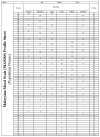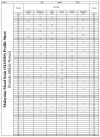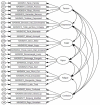Cross-Cultural Validation of the Malaysian Mood Scale and Tests of Between-Group Mood Differences
- PMID: 36834041
- PMCID: PMC9959200
- DOI: 10.3390/ijerph20043348
Cross-Cultural Validation of the Malaysian Mood Scale and Tests of Between-Group Mood Differences
Abstract
Mood measures have been shown to have utility for monitoring risks to mental health and to predict performance among athletes. To facilitate use in a Malaysian context, we tested a Malay-language version of the 24-item Brunel Mood Scale (BRUMS), referred to as the Malaysian Mood Scale (MASMS). Following a thorough translation-back-translation process, the 24-item MASMS was administered to 4923 Malay-speaking respondents (2706 males, 2217 females; 2559 athletes, 2364 non-athletes), ranging in age from 17 to 75 years (M = 28.2 years, SD = 9.4 years). Confirmatory factor analysis supported the six-factor MASMS measurement model (CFI = 0.950, TLI = 0.940, RMSEA = 0.056 [CI 0.055, 0.058]). Convergent and divergent validity of the MASMS were supported via relationships with depression, anxiety, and stress measures. Significant differences in mood scores were found between athletes and non-athletes, males and females, and younger and older participants. Tables of normative data and profile sheets for specific groups were generated. We propose that the MASMS is a valid measure that can be used to monitor mental health status among athletes and non-athletes and that facilitates future mood-related research in Malaysia.
Keywords: BRUMS; MASMS; Malaysia; athlete; cross-cultural; mood; sport; translation; validation.
Conflict of interest statement
The authors declare no conflict of interest.
Figures






References
-
- Lane A.M. The rise and fall of the iceberg: Development of a conceptual model of mood performance relationships. In: Lane A.M., editor. Mood and Human Performance: Conceptual, Measurement, and Applied Issues. Nova Science; Hauppauge, NY, USA: 2007. pp. 1–34.
-
- Lane A.M., Terry P.C. The nature of mood: Development of a conceptual model with a focus on depression. J. Appl. Sport Psychol. 2000;12:16–33. doi: 10.1080/10413200008404211. - DOI
-
- Morgan W.P. Test of champions: The iceberg profile. Psychol. Today. 1980;14:92–108.
-
- Terry P.C. The efficacy of mood state profiling with elite performers: A review and synthesis. Sport Psychol. 1995;9:309–324. doi: 10.1123/tsp.9.3.309. - DOI
-
- McNair D.M., Lorr M., Droppelman L.F. Manual for the Profile of Mood States. EdITS; San Diego, CA, USA: 1971.
Publication types
MeSH terms
LinkOut - more resources
Full Text Sources
Miscellaneous

